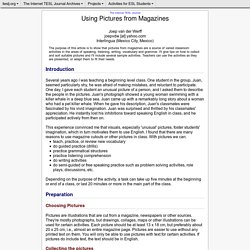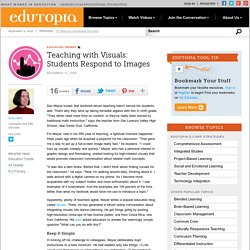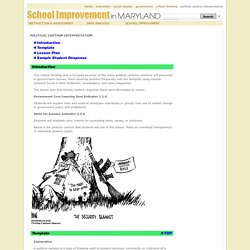

Using Picture Books to Teach Characterization in Writing Workshop. ReadWriteThink couldn't publish all of this great content without literacy experts to write and review for us.

If you've got lessons plans, videos, activities, or other ideas you'd like to contribute, we'd love to hear from you. Werff- Using Pictures from Magazines in ESL Classes. The Internet TESL Journal Joep van der Werffjoepvdw [at] yahoo.comInterlingua (Mexico City, Mexico) The purpose of this article is to show that pictures from magazines are a source of varied classroom activities in the areas of speaking, listening, writing, vocabulary and grammar.

I'll give tips on how to collect and sort suitable pictures and I'll include several sample activities. Teachers can use the activities as they are presented, or adapt them to fit their needs. Introduction Several years ago I was teaching a beginning level class. Using Photos With English-Language Learners. "A picture is worth a thousand words.

" -- Unknown Though the origin of this popular adage is unclear, one thing is clear: using photos with English-Language Learners (ELLs) can be enormously effective in helping them learn far more than a thousand words -- and how to use them. Usable images for lessons can be found online or teachers and students can take and use their own.
The activities presented below connect to multiple Common Core Standards including the following ELA Standards: Integrate and evaluate information presented in diverse media and formats, including visually, quantitatively, and orally. Develop the topic with relevant, well-chosen facts, definitions, concrete details, quotations, or other information and examples. Picture Word Inductive Model. How English language teachers can use pictures in class. Larissa Albano, winner of our monthly Teaching English blog award Opens in a new tab or window., is an English teacher based in Italy who blogs at larissaslanguages.blogspot.com Opens in a new tab or window..

She explains how using pictures as a teaching aid can help language teachers engage their students. If I say 'picture', what do you think about? I guess the words 'drawing', 'photo', 'painting', and 'film' might come to mind. As for me, well, I think a picture is much more than an image, especially when I teach English. Guides. Need help with using still images, sound and video for educational purposes?

Explore our free digital media guides. They will take you through the process of finding, creating, managing, delivering and using digital media. The guides have been written specifically for teachers, learners and researchers working in higher education, further education and skills. Teaching with Visuals: Students Respond to Images.
Dan Meyer knows that textbook-driven teaching hasn't served his students well.

That's why they wind up taking remedial algebra with him in ninth grade. "They either need more time on content, or they've really been burned by traditional math instruction," says the teacher from San Lorenzo Valley High School, near Santa Cruz, California. Interpreting Political Cartoons in the History Classroom. What Is It?

A lesson that introduces a framework for understanding and interpreting political cartoons that can be used throughout your entire history course. Rationale Political cartoons are vivid primary sources that offer intriguing and entertaining insights into the public mood, the underlying cultural assumptions of an age, and attitudes toward key events or trends of the times. Since the 18th century, political cartoons have offered a highly useful window into the past. Political Cartoon Interpretation ~ Government Critical Thinking Strategies. This critical thinking skill is included because of the many political cartoons students will encounter in government courses.

Have students practice frequently with the template using sample cartoons found in their textbooks, newspapers, and news magazines. The lesson plan and sample student response sheet were developed to match: Government Core Learning Goal Indicator 1.1.4 Students will explain roles and analyze strategies individuals or groups may use to initiate change in government policy and institutions. Skills for Success Indicator 2.2.4 Students will establish clear criteria for evaluating ideas, issues, or positions.
Cartoon_analysis_worksheet.pdf. Great Resources and Tools for Teaching Using Comic Strips. The use of cartoons in your teaching has several advantages : they give life to those boring and mal-crafted lesson plans, they promote students engagement, they improve students learning, they prolong students attention span, and they also enhance students communicative and linguistic competences.

But when it comes to looking for the educational cartoons and comics to use in the classroom , teachers feel stalled because of the paucity of resources. This is no longer the case, with the list below, you can have free access to dozens of cartoons created specifically to serve teachers needs. We have also provided some web tools in case you want to create your own cartoons. 1- Cartoon Resources 1- Cagle Cartoons This is a great resource for cartoons about education. I really love the work this guy does in this website . 2- Teaching with Cartoons Teaching with Cartoons is like a directory packed full of educational cartoon resources. Inferences_without_captions_packet.pdf. National Archives Experience. Teachers' Resources. Tops.pdf. Teacher Resources.
The Library of Congress offers classroom materials and professional development to help teachers effectively use primary sources from the Library's vast digital collections in their teaching.

Find Library of Congress lesson plans and more that meet Common Core standards, state content standards, and the standards of national organizations. Discover and discuss ways to bring the power of Library of Congress primary sources into the classroom. Go to the blog Subscribe to the blog via e-mail or RSS. Using Primary Sources.
A Picture’s Worth. Social Studies. Hofer, M., & Swan, K. O. (2005). Digital image manipulation: A compelling means to engage students in discussion of point of view and perspective. Using Historical Photographs in Teaching - History and Using Photographs in Teaching. Period photographs, along with other primary source documents, are engaging yet deceptive historical tools that should become an important part of any educational experience if available. Two important points, however, need to be considered when using these historical documents. Dates must be established. If the date of a photograph is not known it can be difficult if not impossible to understand exactly what has occurred.
Look at this Civil War picture of the Atlanta City Hall with an encampment on the grounds. A natural assumption might be that this was a Confederate camp placed there to protect the city. 06465_no7.pdf. Using Pictures to Build Schema for Social Studies Content. ReadWriteThink couldn't publish all of this great content without literacy experts to write and review for us. If you've got lessons plans, videos, activities, or other ideas you'd like to contribute, we'd love to hear from you. Using Visual Materials as Historical Sources: A model for Studying State and Local History. Using Visual Materials as Historical Sources: A model for Studying State and Local History The Social Studies, March/April 1990, pp 84-87 A Questioning Model for Using Historical Photographs.
Picture_Perfect_Science_3-6.pdf. Images of Science. Photo Credit: Science NetLinks Purpose To understand the diversity of the scientific enterprise. Context. Reading images: an introduction to visual literacy. “Literacy” usually means the ability to read and write, but it can also refer to the ability to “read” kinds of signs other than words — for example, images or gestures. The proliferation of images in our culture — in newspapers and magazines, in advertising, on television, and on the Web — makes. Visual Literacy: Lesson Plans. Digital Activities For Visual Literacy. Visual literacy is the ability to construct meaning from or communicate meaning through information presented in the form of an image.
Teaching Visual Literacy to Students. Visual literacy is a multi-faceted subject matter, and faculty wishing to include images in their curriculum can quickly find themselves overwhelmed by the prospect of addressing visual literacy. Common Core in Action: 10 Visual Literacy Strategies. EyeWitness to History - history through the eyes of those who lived it. Cultural Institute. Smithsonian's History Explorer. Teaching History Resources - Historic Newspapers. Looking after the world’s largest private archive of original newspapers means that we’re extremely passionate about history. UFDC Home - All Collection Groups. What’s Going On in This Picture - The Learning Network Blog.
Photo Updated: June 2, 2015. Viewcontent.